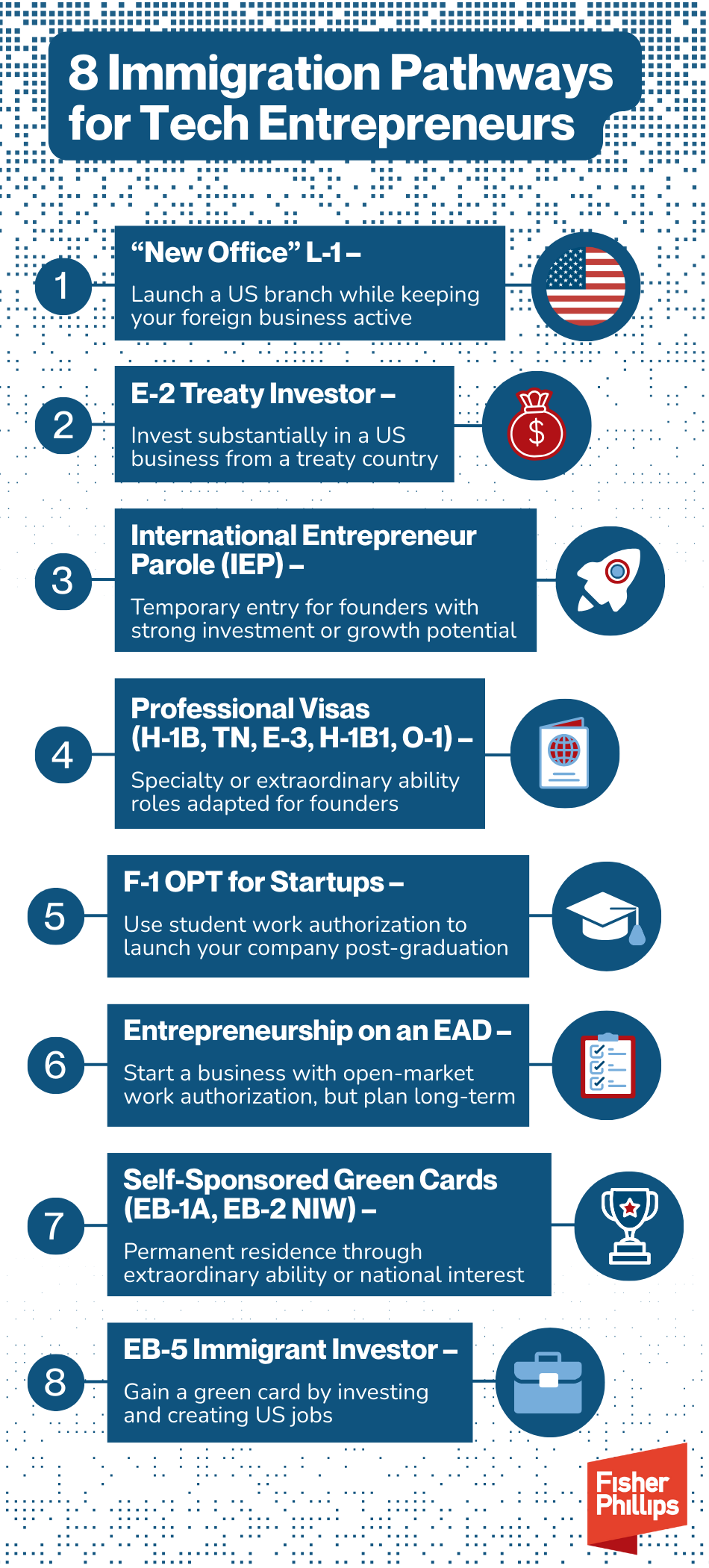Navigating US Immigration: 8 Key Visa Pathways for International Tech Startups
Insights
9.03.25
For tech entrepreneurs, the US market offers unmatched opportunities for innovation and rapid growth, but navigating the immigration landscape can be complex. Before a startup can take advantage of America’s deep capital markets, talent pool, and customer base, its founders and employees must clear the critical immigration hurdle. The good news is there are several visa and employment authorization options available to founders and/or initial employees of tech companies who want to live and work in the US. What are eight visa pathways you should consider?
Quick Overview
When it comes to your immigration options, there is no one-size-fits-all solution; the US does not offer a single “startup visa.” Founders should consider both short-term and long-term goals, and each option carries its own eligibility requirements, documentation standards, and strategic considerations. The best choice will depend on many factors, including:
- Country of citizenship
- Size and type of business
- Whether the US venture will be an affiliate office of an existing company abroad
- The amount to be invested
- Whether the candidate already holds another US nonimmigrant status
- The personal credentials and prior achievements of the candidate
In addition, each visa category can involve unique employment law obligations that affect how the company is structured and how founders work day-to-day.
8 Immigration Options for Tech Startups
Below are eight of the most common paths that tech entrepreneurs should consider, with a brief overview of each.
- “New Office” L-1: For entrepreneurs expanding a foreign company to the US, the L-1 “new office” visa is a powerful option and especially useful for scaling. It requires proof of an active business abroad, a qualifying ownership relationship, and a credible launch plan in the US. Founders must show a real employer–employee relationship, defined managerial or executive duties, and milestones for the first year. Challenges include demonstrating that the overseas operations remain active, planning for US job creation, and addressing “owner-operator” concerns through corporate governance.
- E-2 Treaty Investor: Nationals of investment treaty countries may qualify by making a substantial, personal investment in a real, operating US business. The business cannot be “marginal” (i.e., one that is not sufficient to provide more than a minimal living for the investor), and an applicant must present a strong business plan. This option is particularly attractive to hands-on founder-operators. In conjunction with this approach, a short-term B-1 Business Visitor visa may also allow treaty nationals to enter temporarily to complete setup activities, like signing leases or contracts, while waiting for an E-2 approval.
- International Entrepreneur Parole (IEP): IEP allows certain startup founders to be granted temporary parole into the US if they can show strong investment backing, government funding, or exceptional growth potential. While it seems like a natural option, approvals have been limited, and the process is often unpredictable. It can work in select situations but remains a risky and discretionary choice.
- Professional Categories including H-1B, TN, E-3, H-1B1, O-1: Employer-sponsored visas can sometimes be adapted to founder roles if the US entity has true oversight of the position. Establishing a board of directors or similar oversight mechanism is key.
- H-1B, TN, E-3, and H-1B1 depend on specialty occupation and nationality rules, with timing and quota issues to manage.
- O-1 may be ideal for founders who can demonstrate extraordinary ability with strong third-party recognition.
- The TN, E-3, and H-1B1 categories are similar to H-1B, but limited to citizens of Canada, Mexico, Australia, Singapore, and Chile.
- F-1 OPT for Founder-Led Startups: Recent US graduates may use post-completion Optional Practical Training (OPT) work authorization to pursue their own startup, if they are able to document a legitimate employer relationship, supervision, and appropriate duties. This can serve as a bridge to longer-term status if the business gains traction. ‘STEM’ OPT extensions can be available in qualifying fields. In addition, a related cap-exempt H-1B sponsorship – one that is not subject to the usual quota on the category – may be available if the entrepreneur works “at” a university, for example to access specialized lab equipment.
- Entrepreneurship on an EAD (H-4 spouses, L-2 spouses, Asylum applicants, and others): Individuals with open-market work authorization pursuant to an Employment Authorization Document (EAD) can start and operate their own companies. Because EADs are temporary, founders often look to transition into a longer-term visa or permanent residence category as their businesses grow.
- Self-Sponsored Green Cards (EB-1A and EB-2 NIW): These permanent residence paths do not require an employer sponsor. Lawful Permanent Residence for a Person of Extraordinary Ability (EB-1A) is for top achievers with sustained, international acclaim in their field. A National Interest Waiver (EB-2) is for founders whose work has clear merit and national importance and who can show they are well-positioned to advance the endeavor. Serial entrepreneurs with a proven track record of accomplishments often make strong EB-1A candidates, while newer founders with strong capabilities in critical fields such as healthcare, defense, education, or technology may succeed with an NIW.
- EB-5 Immigrant Investor: This green card category is based on a qualifying investment in a US business that creates jobs. Substantial capital is required, along with detailed documentation of investment funds and a compliant job creation plan. Regional center programs and targeted employment areas can affect minimum thresholds. This option works best for well-capitalized founders with a clear structure and compliance strategy.
Conclusion
For support in selecting the most appropriate strategy for your business, please contact your Fisher Phillips attorney, the authors of this Insight, or any member of our Immigration Practice or Technology Industry Team. Make sure you are subscribed to Fisher Phillips’ Insight System to receive the most up-to-date information directly to your inbox.
Related People
-
- Brian J. Coughlin
- Partner
-
- Brett P. Owens
- Partner


